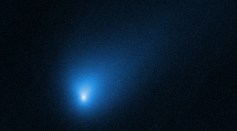Tags: Hubble Space Telescope
[Listen] NASA's Sonified Hubble Deep Space Image of the Galactic Treasure Chest Will Give You Chills
First Exoplanet Discovered by NASA’s Hubble Space Telescope Suddenly Disappeared, Where Could It Possibly Go?

Two Young Super Puffy Exoplanets Discovered by Hubble Space Telescope

Hubble Telescope Takes Sharpest Image Yet of First-Ever Confirmed Interstellar Comet
Einstein's General Theory of Relativity is Confirmed With The Hubble Space Telescope
The European Extremely Larger Telescope Is Now Under Construction, Gets The Green Signal From ESO Council
Black Hole Quietly Born From Collapsing Massive Star That Skipped Its Supernova Stage
Hubble Telescope Spotted Galaxy Duo Rushing Past Each Other At Lepus ‘The Hare’ Constellation
Jupiter May Possibly Have Solid Core Beneath The Gas Surface: Latest Image From Juno Reveals
Hubble Space Telescope Discovered A Bright Shining Lizard Star Hiding In A Constellation; NASA Space Telescope’s Successor Is Set To Go
Hubble Captures Bubble-Like Structure Wrapped Around Star 5,200 Light Years Away
Hubble Uncovered Venting Activity On Europa; Could It Be Sign Of Life Forms
Hubble Sends Spectacular Images Of Intense Auroras On Uranus
Hubble Space Telescope Image: Spotted Two Interacting NGC3447 Galaxies
Hubble Caught Frisbee-like Galaxy In Action
NASA/ESA Update: Hubble Captured Detailed View Of Milky Way's Closest Galaxy NGC 1448, It Has A Supermassive Black Hole
Black Hole Inside The Milky Way Galaxy Hasn't Eaten For Six Million Years, Hubble Finds
Hubble Telescope Captured The Shining Stars Of Sagittarius
Hubble Space Telescope Gets Another Revamp
Earth-Like Planet Is Venus’s Twin
Most Popular

Texas Official Shot Down Siren Flood Alert, Complaining That It Might Go Off 'In the Middle of the Night': Report

Nvidia's Jetson Thor Could Make Humanoids Smarter Than Ever

Trump's Trillion Dollar Spending Boost For Pentagon to Create Disastrous Amount of Carbon Emissions, Study Shows

Hellfire Missile Video Reveals MQ-9 Reapers Being Used for Aerial Combat




